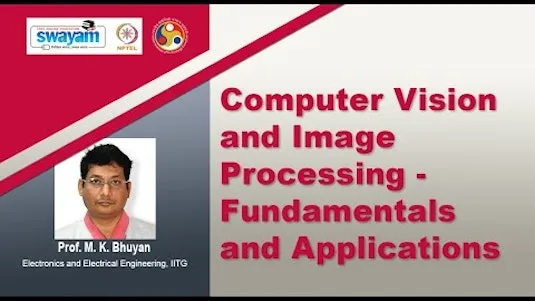
Computer Vision and Image Processing - Fundamentals and Applications 
This course introduces students to the fundamentals of Computer Vision and Image Processing, including image acquisition and formation models, radiometric models, image processing concepts, feature extraction and selection for pattern classification/recognition, and advanced concepts such as motion estimation and tracking, image classification, scene understanding, object classification and tracking, image fusion, and image registration. It is suitable for students interested in research in the field of Computer Vision and Image Processing. ▼
ADVERTISEMENT
Course Feature
![]() Cost:
Cost:
Free
![]() Provider:
Provider:
Swayam
![]() Certificate:
Certificate:
Paid Certification
![]() Language:
Language:
English
![]() Start Date:
Start Date:
22nd Jan, 2023
Course Overview
❗The content presented here is sourced directly from Swayam platform. For comprehensive course details, including enrollment information, simply click on the 'Go to class' link on our website.
Updated in [March 20th, 2023]
This course, Computer Vision and Image Processing - Fundamentals and Applications, is designed to provide students with an introduction to the fundamental concepts and issues of Computer Vision and Image Processing. Students will learn about image acquisition and image formation models, radiometric models of image formation, image formation in the camera, image processing concepts, feature extraction and selection for pattern classification/recognition, and advanced concepts such as motion estimation and tracking, image classification, scene understanding, object classification and tracking, image fusion, and image registration.
This course is suitable for students who are interested in doing research in the area of Computer Vision. Upon completion of the course, students should have the knowledge needed to read and understand more advanced topics and current research literature, and the ability to start working in industry or in academic research in the field of Computer Vision and Image Processing. They can also apply all these concepts for solving the real-world problems.
The intended audience for this course is undergraduate, postgraduate, and Ph.D. students. Prerequisites for the course include basic co-ordinate geometry, matrix algebra, linear algebra, and random process. The software industries that develop computer visions apps would be benefitted from this course.
[Applications]
After completing this course, students will have the knowledge and skills necessary to read and understand more advanced topics and current research literature in the field of Computer Vision and Image Processing. They will also be able to apply the concepts learned in this course to solve real-world problems. Additionally, the software industries that develop computer vision apps will benefit from this course.
[Career Paths]
1. Computer Vision Engineer: Computer Vision Engineers are responsible for developing and implementing computer vision algorithms and systems. They design, develop, and test computer vision algorithms and systems for a variety of applications, such as object recognition, image segmentation, and motion tracking. They also work on developing new techniques for image processing and analysis. The demand for Computer Vision Engineers is increasing due to the growing need for automated systems in various industries.
2. Image Processing Scientist: Image Processing Scientists are responsible for developing and implementing image processing algorithms and systems. They design, develop, and test image processing algorithms and systems for a variety of applications, such as medical imaging, satellite imaging, and facial recognition. They also work on developing new techniques for image processing and analysis. The demand for Image Processing Scientists is increasing due to the growing need for automated systems in various industries.
3. Machine Learning Engineer: Machine Learning Engineers are responsible for developing and implementing machine learning algorithms and systems. They design, develop, and test machine learning algorithms and systems for a variety of applications, such as natural language processing, computer vision, and robotics. They also work on developing new techniques for machine learning and analysis. The demand for Machine Learning Engineers is increasing due to the growing need for automated systems in various industries.
4. Robotics Engineer: Robotics Engineers are responsible for developing and implementing robotics algorithms and systems. They design, develop, and test robotics algorithms and systems for a variety of applications, such as autonomous vehicles, medical robotics, and industrial automation. They also work on developing new techniques for robotics and analysis. The demand for Robotics Engineers is increasing due to the growing need for automated systems in various industries.
[Education Paths]
1. Bachelor of Science in Computer Vision and Image Processing: This degree program provides students with a comprehensive understanding of the fundamentals of computer vision and image processing, including image acquisition and formation models, radiometric models of image formation, image formation in the camera, image processing concepts, feature extraction and selection for pattern classification/recognition, and advanced concepts like motion estimation and tracking, image classification, scene understanding, object classification and tracking, image fusion, and image registration. This degree program is ideal for students interested in pursuing a career in the software industry or in academic research in the field of computer vision and image processing.
2. Master of Science in Computer Vision and Image Processing: This degree program provides students with an in-depth understanding of the fundamentals of computer vision and image processing, including image acquisition and formation models, radiometric models of image formation, image formation in the camera, image processing concepts, feature extraction and selection for pattern classification/recognition, and advanced concepts like motion estimation and tracking, image classification, scene understanding, object classification and tracking, image fusion, and image registration. This degree program is ideal for students interested in pursuing a career in the software industry or in academic research in the field of computer vision and image processing.
3. Doctor of Philosophy in Computer Vision and Image Processing: This degree program provides students with an advanced understanding of the fundamentals of computer vision and image processing, including image acquisition and formation models, radiometric models of image formation, image formation in the camera, image processing concepts, feature extraction and selection for pattern classification/recognition, and advanced concepts like motion estimation and tracking, image classification, scene understanding, object classification and tracking, image fusion, and image registration. This degree program is ideal for students interested in pursuing a career in the software industry or in academic research in the field of computer vision and image processing.
The development trends in the field of computer vision and image processing are rapidly evolving, with new technologies and applications being developed every day. Some of the most exciting developments include the use of deep learning and artificial intelligence to improve image recognition and classification, the development of autonomous vehicles and robots, and the use of computer vision and image processing for medical imaging and diagnostics.
Course Provider

Provider Swayam's Stats at AZClass
Computer Vision and Image Processing - Fundamentals and Applications introduces students to the fundamentals of computer vision and image processing including image acquisition and formation models, radiation models, image processing concepts, feature extraction and selection for pattern classification and recognition, and motion estimation and tracking, Advanced concepts like image classification, scene understanding, object classification and tracking, image fusion, and image registration. It is suitable for students interested in research in the fields of computer vision and image processing. It is a course designed to introduce students to the fundamentals of computer vision and image processing.
Discussion and Reviews
0.0 (Based on 0 reviews)
Explore Similar Online Courses

English&French Translator: Long Short Term Memory Networks

AWS Fundamentals: Going Cloud-Native

Python for Informatics: Exploring Information

Social Network Analysis

Introduction to Systematic Review and Meta-Analysis

The Analytics Edge

DCO042 - Python For Informatics

Causal Diagrams: Draw Your Assumptions Before Your Conclusions

Whole genome sequencing of bacterial genomes - tools and applications

Introduction to Computer Vision

Learn Computer Vision with OpenCV Library using Python


Start your review of Computer Vision and Image Processing - Fundamentals and Applications